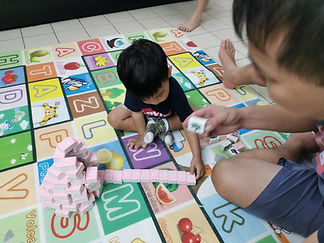
Occupational Therapy and Play often come hand in hand. This is because play is a major occuational role of childhood. Play is often used as a medium to engage children to address all their OT goals including motor skills, attention and concentration, social skills, self care e.g. dressing
PLAY
Why Play?
- To learn about their physical, social and emotional abilities and skills
- Explore motivation and achievement
- Imaginary world for mastery over unmanageable aspects of reality
- Activation, exploration and wonder
- Build interpersonal relationships
- Develop interest
- Develop concentration and problem solving skills


Social Play Categories
Unoccupied
- not playing, watching things of momentary interest
Solitary
- actively involved in play alone, usually object play, 12-18 months
Onlooker
- watching the play activity of others, may talk to them , doesn’t join play
Parallel
- playing alongside another child or group of children, often related or identical activity, may be similar toys, 24-30 months
Associative
- playing in a group, in an activity all share, but loosely related with no prior play, 30-36 months
Cooperative
- a group plays together on a game all have agreed on, planned for, and established some rules for, 36-42 months

Types of Play
CONSTRUCTIONAL PLAY
Manipulation of objects to construct or create something

DRAMATIC/PRETEND PLAY
Involves pretense, acting out a role
.jpeg)
EXPLORATORY PLAY
Investigation of properties of toy, object, self or others

ROUGH AND TUMBLE PLAY



GAMES WITH RULES

FUNCTIONAL PLAY
Sensorimotor or practice play appropriate to the situation

TECHNOLOGICAL PLAY
Recognition of increasing role that technology has in play repertoire of children


